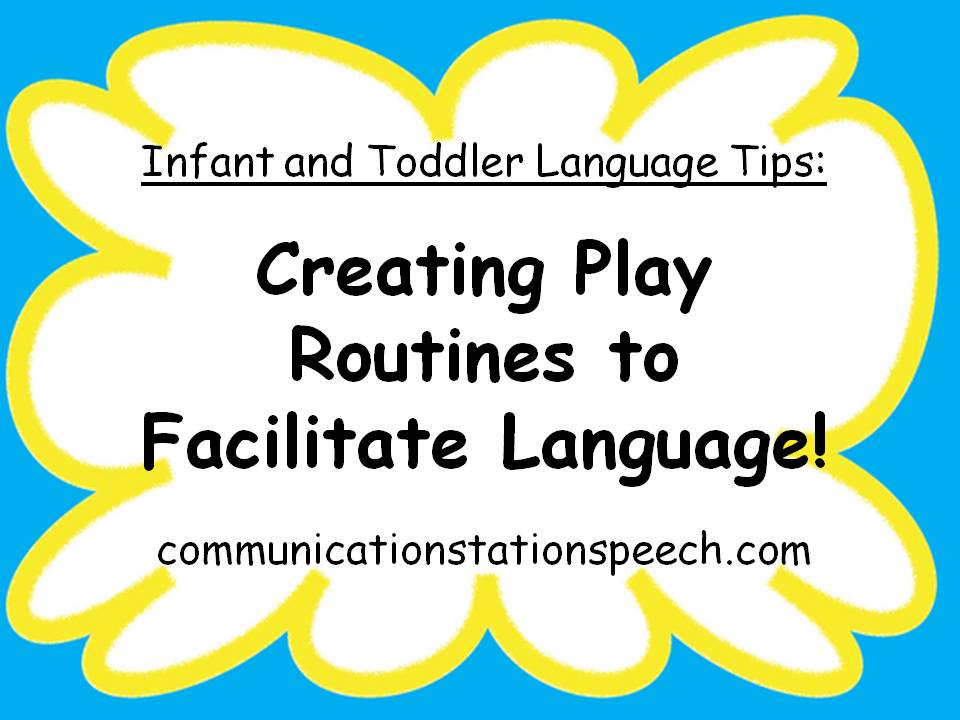Tip Tuesday: Creating Play Routines to Facilitate Language!
The use of routines is one of the simplest ways an adult (parent/caregiver/therapist/educator, etc.) can facilitate language growth in young children. This is especially true for children between 1-3 years of age (or children functioning between this developmental age range). When speaking about routines, most often we think of “steps” to completing an act (e.g. morning routine-getting dressed, eating breakfast, brushing our teeth, etc.). However, the types of routines that will facilitate language growth are what I like to call “play routines”. My technical definition (for all the SLPs out there reading this) of a “play routine” is a pattern of play in which you as the communication partner participate in a motivating, developmentally appropriate activity, while carefully and repetitively presenting simplified language with strategic placement of facilitation techniques which result in imitated language productions from the child. Sounds overwhelming, doesn’t it? Simply put, “play routines” are way in which you repetitively say the same word (or words) in play and wait expectantly for your child to imitate them back to you.
Why do play routines work? There are a number of reasons why play routines work for young children. Hearing the same word repeatedly allows the child to focus solely on that one vocabulary word (without requiring him/her to process or understand additional language). Repetition also helps prime the phonological system to be ready to imitate modeled words. Being at such a young age children can visually watch your mouth repeatedly to see the oral motor movements required to produce that word (or to produce a close approximation of that word) which also aids in imitation. Having the same “order” to play also allows a child to anticipate what word you are going to say and may spontaneously facilitate word imitation without assistance.
Play routines sound so complicated. How would I create a play routine? Here are my 3 simple steps to creating a play routine:
1. Choose a child-centered developmentally appropriate activity: if your child can sit and crawl but cannot yet walk or run, you will choose a stationary activity rather than one that requires a lot of mobility. If your child struggles with fine motor skills, you will choose a gross motor activity that your child can already perform. The goal is to choose an activity in which your child can participate with EASE as the focus should be on imitation of language NOT performing an action.
2. Choose a highly motivating activity: if you know your child loves to play with bubbles, cars, or balls, create play routines around these fun motivating activities. Later, once the idea of routines have been implemented and language growth is observed you can begin to branch out to more adult centered activities or to create play routines with non-preferred activities.
3. Choose an activity with which you can perform at least 3 different actions: this is a “rule of thumb” that I personally follow when choosing play routine activities. If you follow this rule, then one activity will offer development of at least 3 different and new vocabulary words for the child.
What is an example of a play routine? How can I implement play routines at home? Join me next Tuesday when I answer these questions and give you my 3 simple steps to implementing play routines in a child’s home environment.
Happy talking!
Disclaimer: This is an example of one way to use simple parent friendly techniques to encourage language growth in your child. Play routines is ONE technique. It DOES NOT take the place of speech therapy. If your child is resistant or unable to imitate language after you have attempted numerous play activities, I recommend you contact a local speech-language pathologist for further screening and assessment (as necessary).


No comments yet.